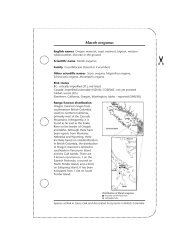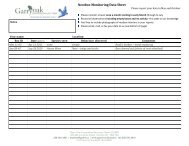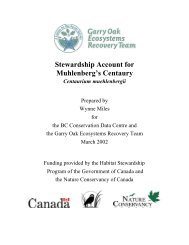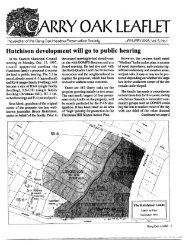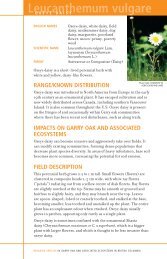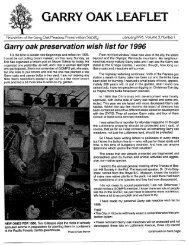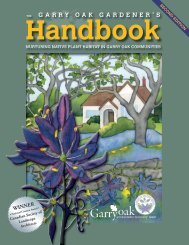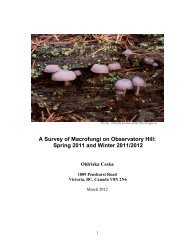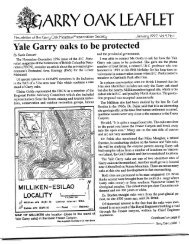Trifolium dichotomum - Garry Oak Ecosystems Recovery Team
Trifolium dichotomum - Garry Oak Ecosystems Recovery Team
Trifolium dichotomum - Garry Oak Ecosystems Recovery Team
Create successful ePaper yourself
Turn your PDF publications into a flip-book with our unique Google optimized e-Paper software.
<strong>Trifolium</strong> <strong>dichotomum</strong><br />
English names branched Indian clover, Macrae’s clover<br />
Scientific name <strong>Trifolium</strong> <strong>dichotomum</strong><br />
Family Fabaceae (Pea)<br />
Other scientific names <strong>Trifolium</strong> macraei var. <strong>dichotomum</strong>, <strong>Trifolium</strong><br />
albopurpureum var. <strong>dichotomum</strong>, <strong>Trifolium</strong> <strong>dichotomum</strong> var. turbinatum<br />
Risk status<br />
BC: imperilled/vulnerable (S2S3); blue-listed<br />
Canada: imperilled/vulnerable (N2/N3); COSEWIC: not yet assessed<br />
Global: apparently secure? (G4?)<br />
Elsewhere: Washington, Oregon, California – reported (SNR)<br />
Range/known distribution<br />
Due to the complex taxonomy, the<br />
global range of the species is difficult<br />
to determine. Branched Indian clover<br />
occurs from Washington and Oregon<br />
to central California, west of the<br />
Cascade Mountains. Reports from<br />
Massachusetts, Iowa and Chile are<br />
likely based on misidentification.<br />
In British Columbia, branched Indian<br />
clover occurs on southeastern<br />
Vancouver Island and adjacent islands.<br />
There are 10 known localities occurring<br />
on 5 of the main Gulf Islands (North<br />
Pender, Mayne, Saltspring, Galiano<br />
and Saturna Islands), and on 2 of<br />
the smaller islands (Georgeson and<br />
Secretary Islands). There is 1 extirpated<br />
population near Nanaimo on southeastern<br />
Vancouver Island.<br />
Distribution of <strong>Trifolium</strong> <strong>dichotomum</strong><br />
l confirmed sites<br />
l extirpated site<br />
Species at Risk in <strong>Garry</strong> <strong>Oak</strong> and Associated <strong>Ecosystems</strong> in British Columbia
<strong>Trifolium</strong> <strong>dichotomum</strong><br />
Field description<br />
Branched Indian clover is a small (10-30 cm) annual with one to several<br />
unbranched, hairy stems. The stems are either erect or lie on the ground<br />
and curve up at the ends. The leaves are alternate with three heartshaped<br />
to rounded leaflets. The ends of the leaflets are either notched<br />
or rounded and there are coarse teeth along the edges. The stipules<br />
(structure at the base of the leaf stems) are egg-shaped with pointed tips<br />
and measure 5-10 mm long. The flower head is egg-shaped or round with<br />
10-60 purple pea-like flowers. Occasionally the flowers are white or pink.<br />
The flowers do not have involucres (a circle of bracts) below the heads.<br />
The sepals form a densely hairy tube with teeth that are longer than the<br />
tube. The fruit is a single seeded pod.<br />
Identification tips<br />
Branched Indian clover may be confused with a number of other annual<br />
native and non-native clovers in British Columbia. The lack of an involucre<br />
below the flower heads, the purple flowers, and the heart-shaped to<br />
rounded leaves that taper at the base distinguish it from other species.<br />
<strong>Trifolium</strong> <strong>dichotomum</strong><br />
Matt Fairbarns<br />
Species at Risk in <strong>Garry</strong> <strong>Oak</strong> and Associated <strong>Ecosystems</strong> in British Columbia
<strong>Trifolium</strong> <strong>dichotomum</strong><br />
Life history<br />
In California, branched Indian clover blooms from April to May. Herbarium<br />
specimens record similar flowering times in British Columbia. Genetic<br />
diversity studies indicate the flowers are both cross- and self-pollinated.<br />
Bumblebees are the primary pollinators for other closely related clover<br />
species. Like other annual species, branched Indian clover may have large<br />
fluctuations in numbers from year to year depending on weather conditions.<br />
Other clover species are known to have hard-coated seeds that can remain<br />
viable for decades. The low growth habit of branched Indian clover may<br />
be an adaptation to extreme coastal weather conditions including strong<br />
winds. The roots of other clover species fix nitrogen.<br />
Habitat<br />
Branched Indian clover occurs on open, grassy bluffs or banks above<br />
the sea. The sites are mesic to dry, steep, south facing slopes. Soils are<br />
shallow, sandy or gravelly, on talus or shale. Elevation ranges from 1-200<br />
m. Commonly associated plants include barren brome* (Bromus sterilis),<br />
rip-gut brome* (Bromus rigidus), annual fescue* (Vulpia sp.), California<br />
oatgrass (Danthonia californica), Wallace’s selaginella (Selaginella wallacei),<br />
Lemmon’s needlegrass (Achnatherum lemmonii), small-flowered blue-eyed<br />
Mary (Collinsia parviflora), silver hairgrass* (Aira caryophyllea) and tomcat<br />
clover (<strong>Trifolium</strong> willdenowii).<br />
Why the species is at risk<br />
Development has destroyed much of the suitable habitat for branched<br />
Indian clover, especially since oceanfront is highly desirable for residential<br />
sites. Most of the remaining populations occur on private land and may<br />
be threatened by road building and construction. Invasive species, such as<br />
orchard grass* (Dactylis glomerata) and Scotch broom* (Cytisus scoparius),<br />
cause habitat degradation and compete with branched Indian clover for<br />
water, light and nutrients. Recreational impacts in steep bluff areas cause<br />
trampling, soil disturbance and erosion. Fire suppression has altered<br />
habitat and increased fuel loading, increasing the potential harm caused<br />
by future fires. The impact of grazing is unclear: branched Indian clover<br />
on Saturna Island may benefit from reduced competition since feral goats<br />
graze invasive species.<br />
Species at Risk in <strong>Garry</strong> <strong>Oak</strong> and Associated <strong>Ecosystems</strong> in British Columbia
<strong>Trifolium</strong> <strong>dichotomum</strong><br />
What you can do to help this species<br />
Management practices should be tailored to the specific circumstances<br />
at the site. Potential management tools will depend on the specific<br />
circumstances and may require experimentation prior to implementation.<br />
Before taking any action, expert advice must be obtained and no<br />
action taken without it. Please refer to the introductory section of<br />
this manual.<br />
Public and private landowners should be made aware of new populations<br />
of this species if they are discovered, and appropriate management<br />
practices suggested. Existing populations should be monitored on an<br />
ongoing basis to determine their viability, as well as for any negative<br />
impacts stemming from land development, trampling, fire suppression<br />
and weed encroachment.<br />
References<br />
British Columbia Conservation Data Centre. Botany Program. 2008.<br />
Database containing records of rare plant collections and observations in<br />
the province of British Columbia.<br />
Costanzo, B. 2002. Stewardship Account for Branched Indian Clover<br />
<strong>Trifolium</strong> <strong>dichotomum</strong>. Prepared for the BC Conservation Data Centre<br />
and the <strong>Garry</strong> <strong>Oak</strong> <strong>Ecosystems</strong> <strong>Recovery</strong> <strong>Team</strong>. Sponsored by the<br />
Habitat Stewardship Program, Government of Canada and National<br />
Conservancy of Canada. Victoria BC.<br />
Knapp, E.E. and P.G. Connors. 1999. Genetic consequences of a<br />
single-founder population bottleneck in <strong>Trifolium</strong> amoenum (Fabaceae).<br />
American Journal of Botany 86(1): 124-130.<br />
For further information, contact the <strong>Garry</strong> <strong>Oak</strong> <strong>Ecosystems</strong> <strong>Recovery</strong> <strong>Team</strong>,<br />
or see the web site at: www.goert.ca.<br />
Line art reprinted with permission of the University of Washington Press. Photograph reprinted<br />
with permission of Matt Fairbarns.<br />
© 2008 *Refers to non-native species<br />
Species at Risk in <strong>Garry</strong> <strong>Oak</strong> and Associated <strong>Ecosystems</strong> in British Columbia




